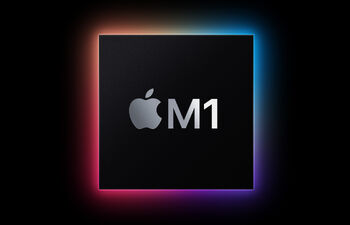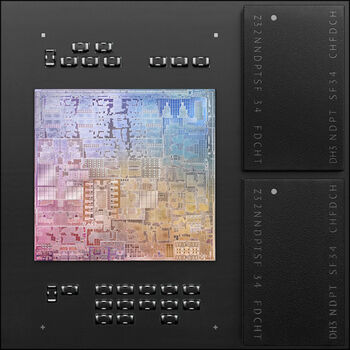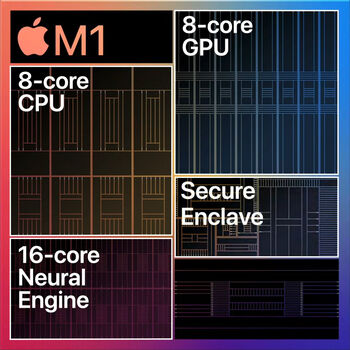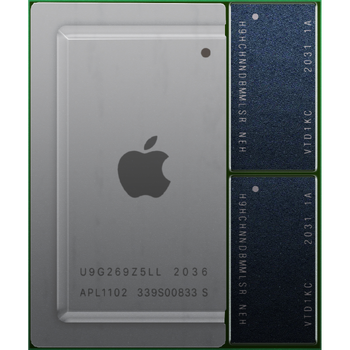Apple M1
Nội Dung Chính
Apple M1

-
Package
-
Schematic
-
Exterior



Product ID
APL1102 (part no.)
T8103 (internal)
Developer
Apple Inc.
Fabricator
TSMC
Type
System on a chip (SoC)
Announced
November 10, 2020
Released
November 17, 2020
Features
4 high-performance CPU cores
4 high-efficiency CPU cores
7 or 8 GPU cores
16 Neural Engine cores
Thunderbolt 3 / USB4 controller
Secure Enclave
RAM
8 or 16 GB DRAM on package
Specs
16 billion transistors
3.2 GHz base clock rate 16 billion transistors
Dimensions
2 (die)
120.5 mm
Variants
Apple M1 Pro
Apple M1 Max
Apple M1 Ultra
Successor
Apple M2
Web page
apple.com/mac/m1 (archived)
The Apple M1 is an ARM-based system on a chip (SoC) designed by Apple. The first to be developed for the Mac line of computers, the M1 was introduced by Apple during a special event on November 10, 2020 for the MacBook Air, 13-inch MacBook Pro, and Mac mini.[1] On April 20, 2021, Apple announced that the M1 would be incorporated into the redesigned 24-inch iMac and 5th-generation iPad Pros.[2]
Specifications
The M1 is manufactured by TSMC to Apple’s design specifications.[3] The 120.5 mm2 die contains 16 billion transistors that are fabricated through a 5 nm process. Dynamic RAM (DRAM) is built onto the package and is shared through Apple’s unified memory architecture (UMA) to eliminate the need to copy data from the CPU to GPU, which are both part of the package.[4][5]
The 8-core CPU contains four high-performance cores and four high-efficiency cores, similiar to the ARM big.LITTLE architecture used by mobile devices for power efficiency. The GPU contains 8 cores for graphics, though only 7 are activated in the entry-level MacBook Air, indicating the practice of binning.[6] The Neural Engine contains 16 cores for machine learning performance. A Thunderbolt 3 and USB4 controller is included on the chip. It also includes its own Secure Enclave,[4] a security feature previously controlled in Macs by a separate Apple T1 or T2 chip.[7]
Performance and compatibility
Apple advertises 3.5x faster performance running native software over previous models. Compatibility with Intel software is provided through Rosetta 2 emulation, with a reported performance hit of about 21-22%, still exceeding the speed of Apple’s Intel-based models. The first operating system from Apple to natively support the M1 is macOS Big Sur, which can also natively run iPadOS applications on the M1.[4][8][9]
Geekbench results indicate that the M1 processor in the latest MacBook Air is operating at a base clock rate of 3.2GHz, delivering performance comparable to that of an entry-level Intel Xeon-based 3rd generation Mac Pro, faster than an Intel Core i9-based 16-inch MacBook Pro, and nearly double the multicore performance of an Apple A14.[10][11]
Limitations
DRAM must be ordered in advance in 8 or 16 GB configurations as they are part of the M1’s SoC package.[4][6] Larger memory configurations were not available at the time of its launch. The first M1-based Macs only support two USB4 ports and do not work with external GPUs.[12]
Variants
In a special event on October 18, 2021, Apple introduced the Apple M1 Pro with support for up to 32 GB of RAM at 200GB/s memory throughput, and Apple M1 Max with support for up to 64 GB of RAM at 400GB/s memory throughput. These were used in the 14 and 16-inch MacBook Pros.[13][14]
During another special event on March 8, 2022, Apple introduced the Apple M1 Ultra with support for up to 128 GB of RAM at 800GB/s memory throughput for the Mac Studio.[15]
References
Articles






